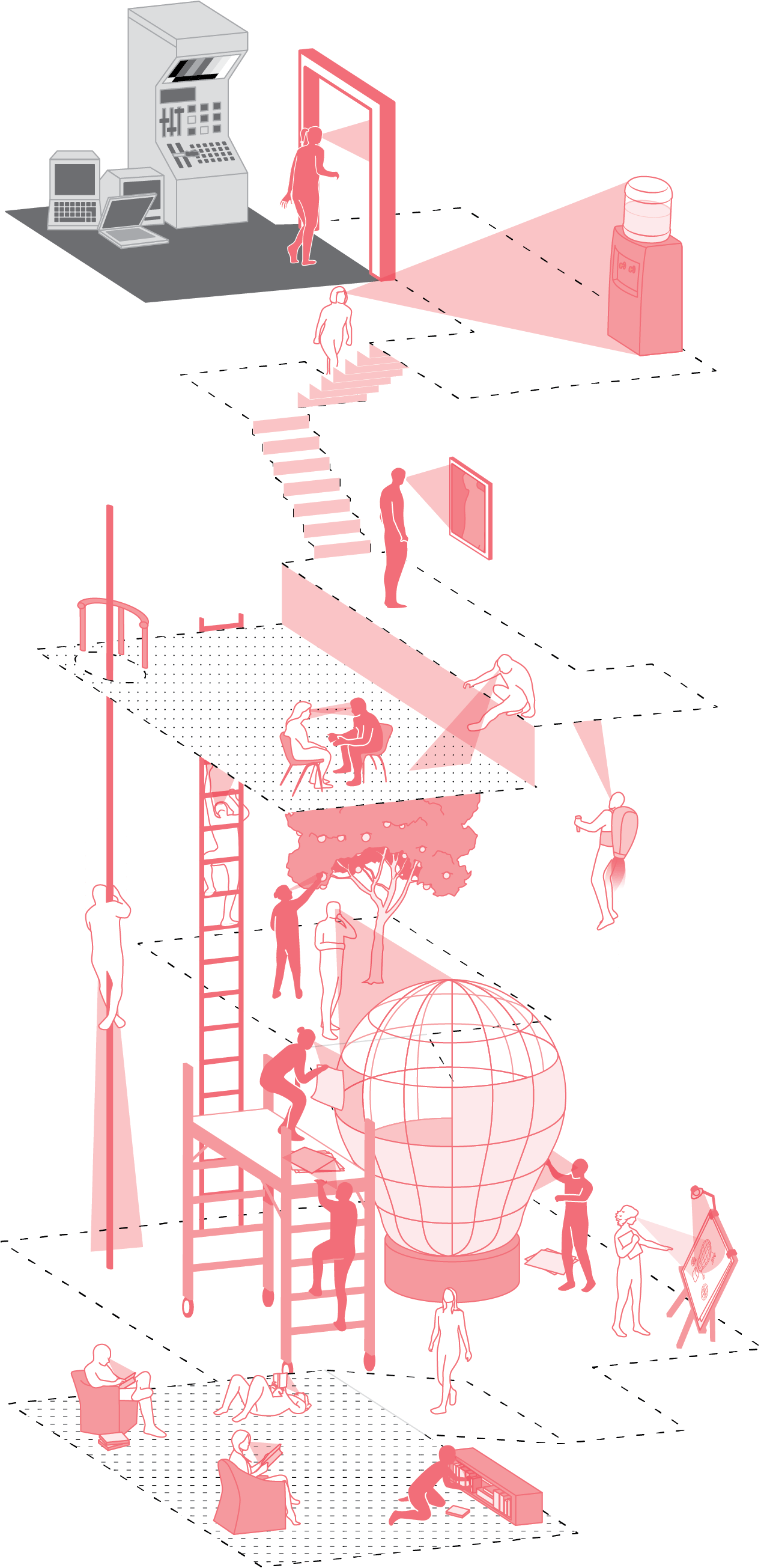Today the types of services, forms of media, and methods of creation a designer will confront in their future career are as broad in scope as they are uncertain. It’s no longer reasonable to study only a discrete area of specialization that may, four years later, be largely outdated. Design education has begun to focus more on fundamentals, design thinking, and design research, partly in response to this uncertainty, and with the belief that it will prepare students for unknown challenges. Specialization can’t be overlooked completely, though learning to learn independently and for life will prepare students to be responsive to the changes certain in today’s industry. Institutions must also adapt to these changes, as financial and physical constraints impact the delivery of curriculum; these rapid changes challenge decisions that assign limited resources to ever evolving needs. Meta-design offers a new way of conceptualizing how we teach, what we teach, and with what resources.
As a form of design practice, meta-design places significant emphasis on the process side of design, and the need for a model that is dynamic and adaptable. It involves the creation of socio-technical environments in which people can be creative, and has been clearly characterized as the “objectives, techniques, and processes for creating [. . .] environments that allow the owners of problems to act as designers” [2]. Central to the concept of meta-design is that these environments enable users to “engage in informed participation rather than being restricted by the use of existing systems” [2]. Meta-design does not define a product or specify an outcome; rather, it defines and designs the conditions for a process of interaction [2]. By focusing on the general structures and processes, rather than on fixed objects and contents, meta-design seeks to better anticipate unforeseen changes, with an eye toward adaptation [4].
Many of the principles upon which meta-design is based have pedagogical applications for post-secondary educators, particularly in the context of art and design universities, where creativity and innovation are highly valued. I’ve often applied meta-design principles to my class curriculum, in a process that allows for improvisation, iteration, reflection, adjustment to individual student strengths and challenges, and collaboration with both students and community stakeholders. While this method can pose many challenges to students who are more familiar with structured regimens,
it encourages invention, autonomy, responsibility, and even play. All of these levels of engagement are central for developing the skills needed to prepare students for what Horst Rittel refers to as wicked problems [5], that are “ill-formulated, where the information is confusing, where there are many clients and decision makers with conflicting values, and were the ramifications in the whole system are thoroughly confusing” [1]. Meta-design principles provide tools for students in approaching design problems, but also provide tools for instructors in teaching students about design.
One important aspect of meta-design is the development of systems that enable the creation, evolution, and dissemination of shared bodies of knowledge. John Thackara refers to this as conviviality, and quotes NYU law professor Yochai Benkler’s description of this commons-based peer production:
We are seeing the emergence of a new mode of production, distinguishable from the property and contract-based modes of firms and markets. Its central characteristic is that groups of individuals successfully collaborate on large-scale projects following a diverse cluster of motivational drives and social signals — rather than market prices or managerial commands [6].
Wikipedia and open source software are some well-known examples of the results of meta-design. The Mozilla Foundation develops a wide range of open source computer applications, from web browsers and mail programs to something called Jetpack. The Jetpack project was created to make the development of browser plug-ins and add-ons accessible to a wider group, ostensibly facilitating the development of these add-ons by users themselves through web languages such as HTML, CSS, and Javascript. This is more than user-generated content; users are developing the programs themselves through everything from beta-testing to writing in code snippets that build out greater capabilities, using everyday language and leveraging existing mash-up applications to make for more efficient user-experiences and communications. Most of these mash-up applications themselves are meta-design projects. Facebook, for example, provides add-ons, extensions, and other services that have been developed by users; the content itself is all user-generated, and is often drawn from another mash-up application such as YouTube or WordPress. WordPress, too, is a meta-design project, with users designing page templates called themes, developing extensible add-on applications for embedding in blogs, and linking to data from other mash-ups such as Twitter or Instagram. There are hundreds, if not thousands, of these new Web 2.0 technologies and applications in various stages of ongoing development, most of which would not exist if it were not for the principles and methodologies of meta-design. What makes this environment so intriguing is that these open design systems are all interacting with and feeding one another. This network is so organic, dynamic, and complex that it couldn’t ever be effectively mapped, but it might be analogous to a garden where plants, insects, soil, sun, and water all interact in a highly complex eco-system. Through meta-design, designers and users gain the benefits of a complex system with multiple inputs, where users are encouraged to create not just content, but to adjust the system itself, creating systems that evolve in response to user demands.
Meta-design embraces the notion that the required knowledge to solve complex problems is beyond the scope of one individual or discipline.
The emphasis on multi-disciplinary collaboration that exists within meta-design embraces the notion that the required knowledge to solve complex problems is beyond the scope of one individual or discipline and that in true collaborative and co-creative environments, participants teach and instruct each other. In this case, the role of the designer is one of facilitator and co-designer of systems that will enable access by user-designers to various practical bodies of knowledge and experts, whether pedagogical or practical, specialist or layman. Both at design time, when the system itself is being developed, and at use time, when user-designers continue the meta-design project, there is an understanding that social creativity emerges when participants teach and instruct one another. As Elisa Giaccardi explains:
Keeping the system open to participation and evolution at use time is meant to join social and technical systems, not only to make them optimized and efficient, but also to let new conditions, interactions and relationships emerge. In this way — by sustaining emergence and evolution — new forms of sociability and creativity can develop and innovation can be fostered [4].

I recently taught a Web Practices class that may provide a practical example of how one might begin applying meta-design to pedagogical practice. The course was multi-disciplinary, with students coming from visual arts, interaction design, and communication design, and from a wide knowledge background. As a result, the students assigned their own learning outcomes based on their current knowledge and near-term career objectives. Based on those proposed outcomes, students were provided with customized resources to enable them to learn the knowledge they needed to succeed. This learning process was supported by lectures that specifically avoided addressing a discrete skill or knowledge base; one such lecture focused on helping students better conceptually understand working with CSS pre-processors, and some of the tools and resources that would support that practice. Providing resources became a pedagogical imperative, at times requiring a pivot where resources or even learning objectives were determined to be inappropriate. The students themselves were very important resources for each other and, in some cases, for students of future courses. Students with different knowledge supported one another and, as part of their project deliverables, created learning resources that contributed to the larger community knowledge base and will help future students in the course. Rather than having institutional tools and technology imposed on them, students chose, individually or collectively, based on what they were most comfortable working with and what they deemed appropriate for the task. Web and desktop applications like Coda, TextMate, Codekit, Axure, and Codiqa became new alternatives to Adobe, while cloud-based sharing and networking, through services like Gmail and Dropbox, were preferred over the institution’s email and server network. These applications, to name a few, became the tools of choice, and an open web of familiar options enabled students to develop their own creative platform for project development. In this case, we can see how users (students) can direct a system (the class) to suit their individual needs, drawing on knowledge and skills from diverse disciplines and sources, including each other, while also creating a foundation for future users.
From a meta-design standpoint, the instructor plays a dual role in the classroom as a designer of the pedagogical system and as an active facilitator, while the student (as primary stakeholder), acts as a user-designer of their own educational process [3]. While this more amorphous teaching and learning method can present workload concerns for faculty, the role of instructor as designer of the system should also lead to a mitigation of those concerns. Attention becomes focused on the roles of facilitation, resource development (acquisition, curation, creation), and system iteration in collaboration with user-designers (students).
Exigent challenges to post-secondary art and design institutions are creating a need to rethink what we teach, how we teach it, and to whom. Reduced revenue to universities from various sources is challenging the quantity and variety of courses being offered while, at the same time, we’re seeing increased industry demand for more diverse skills and knowledge, even from within discrete fields of practice. Internationalization creates new opportunities for diversity in student enrolment and enriching the learning environment, but it also poses pedagogical challenges, particularly when adhering to traditional methods and criteria for delivery and evaluation. Infrastructure too is facing its own pressures; with physical space limitations and capital budget reductions, we need to change the way we think about the classroom, its physical form, and all the equipment that traditionally supports it. All of these shifts create a situation where adhering to traditional standards and methods creates a suboptimal teaching and learning experience — new methods can offer solutions to these evolving circumstances.
In meta-design, we see an evolution of design methodologies to more democratized forms of design. What began as an early 20th century modernist approach that expected users to adapt to the designed outcome has transformed to design methodologies that create new opportunities for users to become engaged participants in the co-creative practice of designing solutions to their own unique problems. As diverse social and economic pressures are applied to post-secondary education, innovative approaches to pedagogical methodology are required. The democratizing principles and practices found in meta-design can be applied to art and design pedagogy, not only to rethink the role of the student in their own education, but to entirely re-conceptualize what a framework for post-secondary art and design education might look like.
References
- [1] Buchanan, R. “Wicked Problems in Design Thinking.” Design Issues 8.2 (1992): 5–21.
- [2] Fischer, G. “Meta-Design: Beyond User-Centered and Participatory Design.” Proceedings of HCI International 2003. June 2003, Crete, Greece. Ed. Constantine Stephanidis. Mahwah: Lawrence Erlbaum Associates, 2003. 88–92.
- [3] Fischer, G. “Symmetry of Ignorance, Social Creativity, and Meta-design.” Proceedings of Creativity & Cognition. 1999. New York: ACM Press, 1999. 116–123.
- [4] Giaccardi, E. “Metadesign as an Emergent Design Culture.” Leonardo 38.4 (2005): 342–350.
- [5] Rittel, H. W. J. and M.M. Webber. “Dilemmas in a General Theory of Planning.” Policy Sciences 4.2: (1973). 155–169.
- [6] Thackara, J. In the Bubble: Designing in a Complex World. Cambridge: MIT Press, 2005.

